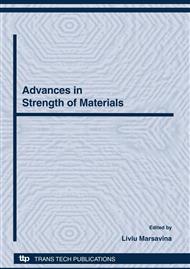p.153
p.161
p.169
p.177
p.185
p.193
p.199
p.205
p.211
In Vitro Experimental Testing of a Cervical Implanted Unit
Abstract:
The paper describes the biomechanical behavior of a cervical implanted unit (CIU) in two conditions: during the physiological and extreme loading. In order to reveal these behaviors, the anatomical structure composed by the C2 and C3 cervical vertebras was implanted using a plate-screws metal structure. The implant was design to perform dynamical, by allowing longitudinal, transversal and rotational movements. The physiological conditions were simulated by the pulsatory negative loading, while the extreme loading was simulated by the alternant symmetrical loading. The tests reveal two behaviors: the durability of the CIU in the physiological loading conditions and the failure of the structure under extreme load.
Info:
Periodical:
Pages:
205-210
Citation:
Online since:
October 2008
Authors:
Price:
Сopyright:
© 2009 Trans Tech Publications Ltd. All Rights Reserved
Share:
Citation:


